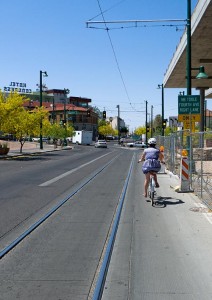
Tucson officials are set to announce they will be using a type of rail for the modern streetcar project that is generally considered more dangerous for cyclists.
For months, streetcar officials have been telling various cycling groups — including the Tucson Pima County Bicycle Advisory Committee — that they will use Block Rail, a new type of rail that has smaller gap that makes it harder for bicycle tires to slip in and drag a cyclist down. Recently however, budgetary and scheduling issues have prompted the streetcar team to revisit the rail type.
While the official announcement won’t be issued until later in the week, several people involved in the project have confirmed there will likely be a switch to Tee Rail, which has a wider gap.
“Due to cost and schedule concerns it appears we may end up with Tee Rail,” Jim Glock, Tucson’s transportation director said. “We are struggling with how to address the bicycling community’s concerns with respect to that.”
According to an email from Glock, Block Rail costs 33 percent more than Tee Rail, which represents $3 million over the entire length of the streetcar route.
In addition, Glock said no one in the United States has actually started producing Block Rail and no one has any experience installing it, which presents risks to the streetcar’s construction schedule.
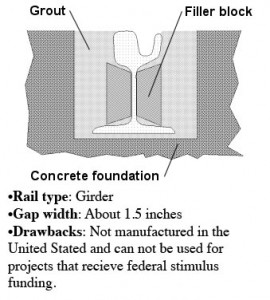 Ian Johnson, the chairman of the downtown subcommittee of the BAC, said he understands the need to complete the project on time without going over budget, but doesn’t want to see cyclists’ safety sacrificed.
Ian Johnson, the chairman of the downtown subcommittee of the BAC, said he understands the need to complete the project on time without going over budget, but doesn’t want to see cyclists’ safety sacrificed.
“With as much public sentiment as there is against the streetcar, I can see why they don’t want to take any chances with delays or cost overruns,” he said. “I can totally understand it, I am very sympathetic. At the same time, as a bicyclist and as a BAC member I am really concerned about the implications.”
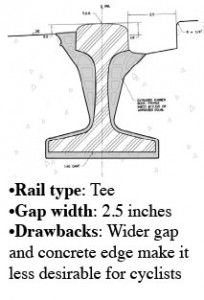 Tee Rail has already been installed in the Fourth Avenue underpass and along Congress Street and Broadway Avenue. According to a July 2010 police report, those tracks may have contributed to a motorized bike rider’s death when he fell attempting to cross the tracks and was struck by a vehicle.
Tee Rail has already been installed in the Fourth Avenue underpass and along Congress Street and Broadway Avenue. According to a July 2010 police report, those tracks may have contributed to a motorized bike rider’s death when he fell attempting to cross the tracks and was struck by a vehicle.
The project requires an American-made rail because it was awarded a federal stimulus grant, which includes a “buy American” clause. That prevented the team from using the European-made Girder Rail, which has the smallest gap of any rail type.
Matthew Taunton is a senior project manager for HDR who helped develop the streetcar’s route before the engineering part of the project was handed off to URS.
He said Portland has decided to use Block Rail for their new streetcar line and that other cities will be looking toward that project. He said if it goes well, Block Rail will become the standard rail used for streetcar projects throughout the United States.
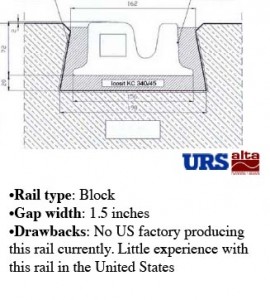 Mark Dorn is a Portland-based engineer for URS, the company doing the engineering work on Tucson’s streetcar and is considered one of the country’s experts on rails. He said said in a webinar on Wednesday that they won’t be able to use the Block Rail he recommended for Tucson’s streetcar.
Mark Dorn is a Portland-based engineer for URS, the company doing the engineering work on Tucson’s streetcar and is considered one of the country’s experts on rails. He said said in a webinar on Wednesday that they won’t be able to use the Block Rail he recommended for Tucson’s streetcar.
“Just last week we were told that we can not use our recommended rail,” Dorn said.
Taunton said in addition to the Tee Rail’s gap being wider, one side of the track is concrete which poses additional problems.
“First of all, it is a wider gap than other rail types. And the concrete tends to chip away,” he said.
The chipping of the concrete makes the gap even wider, making it more dangerous for cyclists.
Block Rail uses steel on both sides, which prevents the chipping.
Glock said they are “acutely aware” of the safety and maintenance issues associated with using Tee Rail and are looking into ways to narrow the Tee Rail gap. He said his engineers have told him they can narrow the gap to something similar to Block Rail and prevent the concrete from chipping.
According to Dorn’s presentation, Block Rail’s gap is 1.5 inches, while Tee Rail’s gap is 2.5 inches, but there are methods to make the gap smaller.
Since he was told they couldn’t use Block Rail, he is recommending the Tucson project use a piece of material that goes between the rail and the concrete to reduce the gap, but even that would still be wider than the preferred Block Rail.
Glock wrote in an email that he believes they can match Block Rail’s gap width while using Tee Rail.
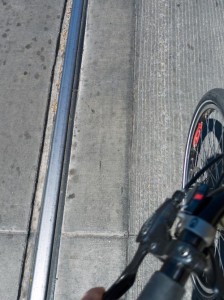
Johnson said the BAC’s downtown subcommittee passed two motions at their last meeting expressing their “great concern” about the use of Tee Rail and directing the city to look at making routes along the streetcar line better for cyclists in other ways should the team ultimately decide to use Tee Rail.
“If in fact they — for whatever reason — go with the less optimal, less safe rail, we are going to ask them to really think about the priorities in the right of way,” Johnson said. “Right now they are making sure there is room for the streetcar, they are making sure there is room for cars and they are making sure there is room for parking. We are really concerned that they are not really prioritizing bikes above parking. We are going to ask they take out parking to provide more room for bikes.”
Taunton said even if Tee Rail is used for the project, it is going to be an improvement over the tracks that are currently on University and Fourth Avenue.
“That is part of the challenge with Tucson,” he said. “[Cyclists] look at what is in the street today, specifically the Old Pueblo Trolley Tracks and they think that Tee Rail that is used for that is what it going to be used for the streetcar, but it is really going to be a totally different environment. It is going to be much improved over what is there today.”

What an incredibly well written and researched article.
Didn’t the paper have an article this weekend about spending almost $600K on unique and artistic streetcar stops? Couldn’t they put that money into safety of other user groups?
http://azstarnet.com/news/local/govt-and-politics/image_0f0656cb-0ff1-578c-ba35-950c7272f8cb.html
The Modern Street Car project has a public art component. It’s money that is directed towards a specific aspect of the project. You can’t just drop the art to fund one 5th of the rail cost upgrade. Monies that arrive with strings attached like the TIGER grant from the Feds have to be spent in specific ways. The buy American stipulation in the TIGER funding along with cost being what’s driving the rail selection choice.
It’s where the track will be placed and the kind of movement over the track bicycles will be forced into that is more important than the type of track. Sure, it will be in better condition (for a while, at least), but there’s going to be twice as much of it and very many times more cyclists having to deal directly with it than the old center lane track.
It’s like anything else. When you start cramming things into a limited space, you have to prioritize or it winds up being a free-for-all….like my desk. I support the Downtown Subcommittee’s and BAC’s call for the city to rank right of way and maintain some order along the route. And, of course, I cannot see ranking space for auto storage above safety and use by cyclists.
I also think it should be done in a way that bikes don’t take the heat for it. It’s the streetcar that is the new thing and causing the change in the game plan.
It’s a Disneyland ride that very few people will use for actual transportation. I have no doubt that folks will drive to a trolly terminus and park their car – then take the trolly to go to 4th Av. and whatever else the trolley will connect to. But it will be like folks going to the mall, it’s a way to have a fun time. The rider fares will never pay back the cost to buy the cars, install the track and pay for electricity to run it, and also maintain the cars, the track, and the overhead wire. You know the bus costs something like $28 per ride to break even. The tax payer covers the difference betwean the actual cost and the fare. The trolley is even more expensive than buses.
The skinny-crack track was dangerous enough, now that they’re going with the plow furrow crack, we get to wait for the cyclist mortality rate to be reported on the news each month. In addition to the loss of life, what about the law-suits that will be filed against our city? You and I get the pleasure of paying the legal fees and settlement costs. I doubt that those expenses were ever factored in when the project’s budget was calculated.
Didn’t Heston’s character on Planet of the Apes have a line like, “It’s a mad-house”? I think that sums it up.
From the story:
In addition, Glock said no one in the United States has actually started producing Block Rail and no one has any experience installing it, which presents risks to the streetcar’s construction schedule.
To which I say:
Sounds like a golden opportunity for some U.S.-based company. Make that two companies. One to manufacture. Another to install.
I agree.
Shhhh, don’t tell anyone, but Tucson Velo is one-upping the Arizona Daily Star when it comes to covering local bicycling issues.
I left a BAC meeting late last year with the notion that Tucson was going to get the block rail; that a mill in Pennsylvania was going to produce it. Updates are easy; transparency is simple. How much of what we hear are misdirected statements meant to appease and put off the bike community?
If this rail is to become the standard for streetcars across the country, let’s hope some U.S. mill will produce it.
That first photo really captures what an absolutely horrible job they’ve done with bicycle safety in that entire area. There has already one person killed by those tracks and I’m sure there will be more. And then trying to enter that underpass from the west makes it clear that whoever is in charge is either completely incompetent or hates bicyclists. Every time I ride through there I’m blown away by how anybody could have managed to so thoroughly botch every detail of bicycle traffic through the new underpass. And every time I walk through it I have to dodge people riding their bikes on the sidewalk because they’re unwilling to risk death on the street.
If there were federal funding available for dedicated bike routes (bikes only) between, say, UA Main Gate and Downtown, in conjunction with the economically silly and dangerous train, then the usual cynical careerism would have compelled them to go after such funding.
As a certain frustrated COT DOT official recently said, “Get a mountain bike.”
This is a great article but it just doesn’t seem like a big deal to me. 1.5″ vs 2.5″? Most road bike & commuter big tires are smaller than that anyway. I fell on the 4th ave tracks, once. Lesson learned. We as cyclists need to take responsability for our own safety once the city has done a reasonable job to do their part. I agree that the south side of the new underpass is pretty messed up for traffic flow of all kinds, pedestrian, cycle and even motorized. But this still doesn’t give us a free pass to ride on the sidewalk. A good idea might have been to move bike traffic to 6th, making it two way & a bike boulevard from somewhere around Rondstat to Drachman. Trying to fit north/south traffic for cars, bikes and a streetcar into the space on 4th is not ideal. Even better would be making 4th ave streetcar, pedestrians & bike only from the underpass to Speedway… As for the comment that this is a “Disneyland” streetcar that no-one will use for transportation, I don’t agree. With almost 2000 beds of student housing going up in the 4th/Downtown area this will get used a lot.
I agree with with your statements about cyclists taking resposibility. Yes, it would be better to have track with a narrower rail gap and streetcars can be dangerous to cyclists, peds, and even cars, but something positive is getting done in the form of a streetcar. An underground subway would be best and pose no conflicts with existing surface traffic but many time more expensive, so sometimes reasonable trade-offs have to be made to get something done.
I also agree the streecar is not a “Disneyland” ride, as 3 wheeler writes. There are numerous highly succesful streetcar systems all over the world that move people for work, school and even shopping efficeintly and cleanly. There is no reason to think ours will be any different, which is being placed in a high-density corridor of businesses, schools and housing. Finally, the notion that light rail “has to pay for itself” is also flawed. Fact is that very few public transportation infrastructure elements that ever “pay for themselves”. If that were a requirement, we would only have toll roads and very few streets, highways and yes, even bike paths.
Infrastructure does indeed pay for itself, moving goods and people allows for a robust economy. The question is not about infrastructure vs. no infrastructure, it’s what gets the best return on investment. We already have paved roads that buses use, how does laying down steel rails for millions of dollars extra make rail more competitive?
First, as a bike fan, I would say bikes are the cheapest, cleanest, most fun and efficient way to move people in a dense urban environment. Cars and SUV’s are least efficient because they create pollution, noise, and take signficant space to move from point A to B and to park (not to mention they typically only transport 1 or 2 people at a time).
That leaves buses and trains. The advantage a rail system has in a dense urban environment is that it represents a public investment in a fixed system / route that, unlike buses, cannot change (easily at least). Because it is a fixed long term investement, it encourages economic development along the route that would otherwise not take place. This is because an investor knows that X people will be travelling along this route on any given day, and the route will not change. The potential to move people for a given economy of scale is greater for rail than that of buses. Examples of this abound, such as in Vancouver that recently built a subway system into it’s downtown. There has been all sorts of economic development around it’s subway stops that previously did not exisit. Again, it’s a new idea to Tucson, but it’s a proven concept in the US and beyond that has been around a long time, and with Tucson at 1/2 million people, it should work. The real test should be how much economic development and activity has taken place over, say 10 years, with light rail than without — not whether the $2 fare can cover all the system costs.
[…] Monday, Tucson Velo reported that the city would use Tee Rail instead of the Block Rail they had planned to […]
I have worked with the “Buy America” law on public works projects for many years. Although the graphic above says non-American made rails cannot be used on projects with federal funds, this is not really true. The Federal agencies have discretion to grant exemptions from the Buy America law for special circumstances. I have acquired these exemptions myself in the past – with appropriate justification. What justification could be better than safety of cyclists?! The Buy America law should not be used as an excuse to use dangerous tail for the streetcar. Cyclists should question the city and federal officials if they try to use this lame excuse.